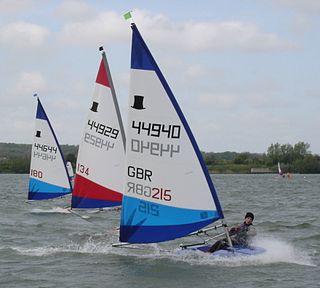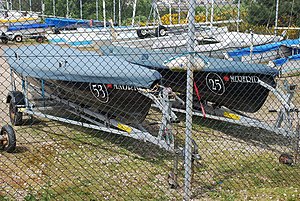
Porthmadog, originally Portmadoc until 1974 and locally as "Port", is a coastal town and community in the Eifionydd area of Gwynedd, Wales, and the historic county of Caernarfonshire. It lies 5 miles (8 km) east of Criccieth, 11 miles (18 km) south-west of Blaenau Ffestiniog, 25 miles (40 km) north of Dolgellau and 20 miles (32 km) south of Caernarfon. The community population of 4,185 in the 2011 census was put at 4,134 in 2019. It grew in the 19th century as a port for local slate, but as the trade declined, it continued as a shopping and tourism centre, being close to Snowdonia National Park and the Ffestiniog Railway. The 1987 National Eisteddfod was held there. It includes nearby Borth-y-Gest, Morfa Bychan and Tremadog.
The Mirror is a type of popular sailing dinghy with more than 70,000 built.

Dinghy racing is a competitive sport using dinghies, which are small boats which may be rowboats, have an outboard motor, or be sailing dinghies. Dinghy racing has affected aspects of the modern sailing dinghy, including hull design, sail materials and sailplan, and techniques such as planing and trapezing.

The Topper is an 11 foot 43 kg (95 lb) sailing dinghy designed by Ian Proctor. The Topper was a one-design boat until 2023 when a new version was produced, and is sailed mostly around the British Isles. It was recognised as a World Sailing Class. The boat previously constructed from polypropylene, and now roto moulded, is popular as a racing boat or for sail training. The class association (ITCA) organise racing events, which range from small travellers to major championships. The RYA run squads alongside the events; in these squads young sailors who are given specialist race coaching.

The GP14 is a wooden or fibreglass hulled double-handed fractional Bermuda rigged sailing dinghy designed by Jack Holt in 1949.
Boat racing is a sport in which boats, or other types of watercraft, race on water. Boat racing powered by oars is recorded as having occurred in ancient Egypt, and it is likely that people have engaged in races involving boats and other water-borne craft for as long as such watercraft have existed.

Aberdyfi, also known as Aberdovey, is a village and community in Gwynedd, Wales, located on the northern side of the estuary of the River Dyfi.

The A-Class Catamaran, often abbreviated to A-Cat, is a development class sailing catamaran for singlehanded racing.

Coastal and offshore rowing is a rowing sport performed at sea. In North America, this sport is often called open water rowing.

The International 14 is a British racing sailboat, crewed by two sailors. The class was established in 1928.
The Celtic Challenge Rowing Race is a 96-mile rowing race from Arklow in Ireland to Aberystwyth in Wales. It is a biennial event which usually takes place on the first Saturday in May. Crews from Wales, Ireland, England and as far afield as Germany compete.

The word Drascombe is a trademark that was first registered by John Watkinson who applied it to a series of sailing boats which he designed and built in the period 1965–79 and sold in the United Kingdom (UK). They comprised the Coaster, Cruiser Longboat, Dabber, Drifter, Driver, Gig, Launch, Longboat, Lugger, Peterboat, Scaffie, Scaith and Skiff, together with a few other one-offs. They have wide and deep cockpits, adaptable boomless rigs and high bulwarks.

Welsh Rowing is the governing body for the sport of rowing in Wales. It is responsible for promoting the sport in Wales, choosing crews to send to the Home Countries International Regatta and the Commonwealth Rowing Championships as well as progressing talented Welsh rowers along relevant pathways into the Great Britain trials and squads. It has 21 affiliated clubs, including schools and universities.

Llandaff Rowing Club is a sport rowing club based on the River Taff in Llandaff, a district in the city of Cardiff, Wales. The club was founded in 1946 and is affiliated to the Welsh Amateur Rowing Association and to British Rowing.

Sport in Cardiff is dictated by, amongst other things, its position as the capital city of Wales, meaning that national home sporting fixtures are nearly always played in the city. All of Wales' multi-sports agencies and many of the country's sports governing bodies have their headquarters in Cardiff and the city's many top-quality venues have attracted world-famous sport events, sometimes unrelated to Cardiff or to Wales.

Bull Bay is a village and bay on the northern coast of Anglesey, Wales, close to Amlwch. Its Welsh name, Porth Llechog, means "sheltered bay". The English name is derived from Pwll y Tarw, which is located near the shore close to the bay.
The Welsh Sea Rowing Association (WSRA) is the national governing body for coastal and ocean rowing in Wales. It is a member of Welsh Rowing and is represented at Welsh Rowing at board level and on the Performance, the Development, Coaching and Education, and the Events Sub-Committees. The WSRA is committed to the continued expansion and development of coastal and ocean rowing in Celtic Longboats and Yoles.
Monmouth Rowing Club is located on the banks of the River Wye in Monmouth, the county town of the historic county of Monmouthshire, Wales. The club is affiliated with the Welsh Amateur Rowing Association (WARA) and hosts several annually organised race events.

John Pierce Rousmaniere is an American writer and author of 30 historical. technical, and instructional books on sailing, yachting history, New York history, business history, and the histories of clubs, businesses, and other organizations. An authority on seamanship and boating safety, he has conducted tests of equipment and sailing skills and led or participated in fact-finding inquiries into boating accidents. He has been presented with several awards for his writing and his contributions to boating safety and seamanship.














